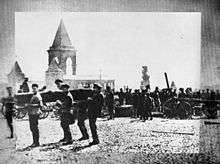Subbotnik
- For the Jewish-identifying community, see Subbotnik Jews.

Subbotnik and voskresnik (from Russian: суббо́та, IPA: [sʊˈbotə] for Saturday and воскресе́нье, IPA: [vəskrʲɪˈsʲenʲjɪ] for Sunday) were days of volunteer unpaid work on weekends following the October Revolution. Initially they were indeed voluntary, but gradually de facto obligatory upon announcement, as people quipped, "in a voluntary-compulsive way" (в добровольно-принудительном порядке).
The tradition is continued in modern Russia and some other former Soviet Republics.[1] Subbotniks are mostly organized for cleaning the streets of garbage, fixing public amenities, collecting recyclable material, and other community services.
The first mass subbotnik was held on April 12, 1919, at the Moscow-Sortirovochnaya railway depot of the Moscow-Kazan Railway upon the initiative of local bolsheviks. It was stated in the Resolution of the General Council of Communists of the Subraion of the Moscow-Kazan Railway and Their Adherents that "the communists and their supporters again must spur themselves on and extract from their time off still another hour of work, i.e. they must increase their working day by an hour, add it up and on Saturday devote six hours at a stretch to physical labour, thereby producing immediately a real value. Considering that communists should not spare their health and lives for the victory of the revolution, the work is conducted without pay."[2] This subbotnik prompted Lenin to write the article The Grand Initiative, where he called subbotniks "the actual beginnings of the communism".
The first all-Russian subbotnik was held on May 1, 1920, and Vladimir Lenin participated in removing building rubble in the Moscow Kremlin, an episode portrayed in a famous painting by Vladimir Krikhatsky, Lenin at the First Subbotnik, of Lenin carrying a log.
Subsequently, "communist subbotniks" and "voskresniks" became obligatory political events in the Soviet Union, with annual "Lenin's Subbotnik" being held in the vicinity of Lenin's birthday.
Subbotnik was also promoted in the 1950s in the Eastern Bloc countries and in particular in the German Democratic Republic (GDR), as the USSR sought to build up the GDR as the westernmost outpost of socialism in Europe.
In Czechoslovakia, a similar kind of work was known as Akce Z ("Action Z"), from Czech word zvelebování, "improvement", referring to the typical activities from garbage removal to housing construction. Folk wit claimed that "Z" stood for zdarma, i.e., "without pay".
See also
References
- ↑ "Riga Subbotnik". Retrieved 2008-09-14.
- ↑ Kaplan (1968) p.359
Bibliography
- Kaplan, Frederick (1968). Bolshevik Ideology and the Ethics of Soviet labor. Philosophical library, New York.